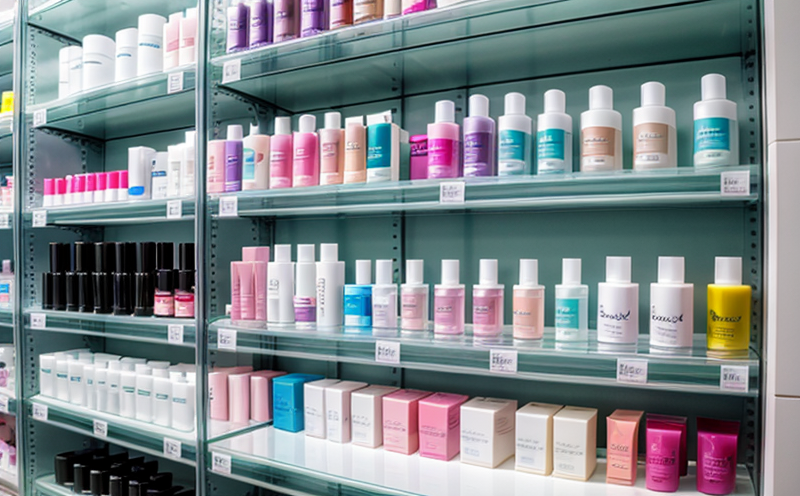Essential Oil Stability Testing in Cosmetic Formulations
The stability and shelf life of cosmetic formulations are critical factors that determine their efficacy, safety, and marketability. Essential oils, due to their volatile nature, can degrade over time under various environmental conditions such as temperature, humidity, light exposure, and storage duration. This degradation could result in loss of aroma, potency, or even the emergence of harmful compounds.
In the cosmetic sector, ensuring the stability of essential oil-based formulations is paramount for maintaining product quality and consumer satisfaction. The stability testing process involves subjecting the formulation to controlled environmental conditions that mimic real-world exposure scenarios. This helps in understanding how these conditions affect the chemical integrity and sensory attributes of the essential oils within the product.
Standard protocols for this testing typically involve placing samples under accelerated aging conditions, such as high temperature and humidity, or exposing them to direct sunlight. The goal is to accelerate potential degradation processes that would occur over longer periods in normal storage or use. These tests are not only crucial for ensuring regulatory compliance but also for enhancing product quality and extending shelf life.
The testing process involves meticulous sample preparation, which includes accurately measuring the essential oils into the cosmetic formulation. The formulations are then stored under conditions designed to replicate real-world exposure scenarios. This could mean using environmental chambers capable of simulating various temperature, humidity, and light levels.
During stability testing, regular assessments are conducted to evaluate changes in key parameters such as the presence of degradation products, loss in aroma profile, and shifts in chemical composition. High-performance liquid chromatography (HPLC) and gas chromatography-mass spectrometry (GC-MS) are commonly used analytical techniques for these evaluations.
The results of stability tests provide critical insights into the shelf life of cosmetic formulations containing essential oils. This information is invaluable for quality managers, compliance officers, R&D engineers, and procurement teams. It enables them to make informed decisions regarding formulation adjustments, storage recommendations, and regulatory filings.
Understanding these parameters not only ensures product integrity but also enhances consumer trust and satisfaction. The data from stability testing can be used to optimize formulations, ensure compliance with international standards such as ISO 2631-1:2020 for human factors in product safety, and enhance overall product quality.
Applied Standards
| Standard Code | Title of Standard | Description |
|---|---|---|
| ISO 2631-1:2020 | Human Factors in Product Safety - Part 1: General Principles and Vocabulary | This standard provides general principles and terminology for the design, evaluation, and improvement of products that are intended to be used by humans. It covers aspects such as ergonomic considerations, safety assessments, and user-centered design. |
| ASTM E2583-17 | Standard Test Method for Determination of Volatile Organic Compounds (VOCs) in Paints and Coatings by Headspace-Gas Chromatography-Mass Spectrometry (HS/GC-MS) | This standard describes a method for the determination of volatile organic compounds in paints, coatings, and other similar products. It is particularly useful in assessing the stability of essential oil formulations. |
| EN 301 844 V1.2.1 (2016-09) | Telcommunications and Media Equipment - Requirements for Electromagnetic Compatibility | This standard specifies the requirements for electromagnetic compatibility of telecommunications and media equipment to ensure that they do not cause harmful interference to other systems. |
| IEC 62368-1:2014 | Information technology - Safety of information technology equipment - Part 1: General requirements for the safety of information technology equipment | This standard provides general requirements for the safety of information technology equipment, including cosmetic products with electronic components. |
Industry Applications
The stability and shelf life testing of essential oil-containing cosmetic formulations is widely recognized across various sectors. For instance, in the skincare industry, it helps in formulating products that retain their efficacy over extended periods without compromising on safety or quality.
In the fragrance sector, this testing ensures that the complex aromas remain intact, providing a consistent user experience. It also plays a vital role in ensuring compliance with regulatory standards such as those set by the European Union's Cosmetics Regulation (EC) No 1223/2009.
For R&D engineers and quality managers, this testing is essential for optimizing formulations, identifying potential issues early on, and making informed decisions about product development. It also aids in meeting the stringent requirements of procurement teams who need to ensure that the products they source meet high standards of quality and safety.
The results of these tests are not only valuable within the industry but can also influence consumer perceptions and brand loyalty. By demonstrating a commitment to rigorous testing, companies can build trust with their customers and enhance their reputation in the market.
Why Choose This Test
Stability testing for essential oil-containing cosmetic formulations is essential for several reasons:
- Ensures Compliance: Regulatory compliance is crucial for any product, and stability tests ensure that the product adheres to international standards such as ISO 2631-1:2020.
- Enhances Quality: By identifying potential issues early on, these tests help in maintaining high-quality formulations.
- Extends Shelf Life: Understanding how environmental conditions affect the product allows for better formulation and storage recommendations.
- Informs Product Development: Data from stability testing can guide R&D engineers in optimizing formulations to meet consumer expectations.
- Builds Trust: Demonstrating a commitment to rigorous testing can enhance consumer trust and brand loyalty.
- Meets Procurement Needs: Sourcing high-quality products that meet stringent standards is essential for procurement teams.
The comprehensive approach taken in these tests ensures that the product remains safe, effective, and of high quality throughout its shelf life. This testing not only meets regulatory requirements but also enhances consumer trust and satisfaction.





